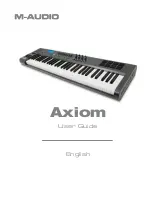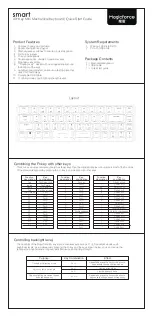
KDFX Reference
KDFX Algorithm Specifications
10-153
902 LFO Sweep Filter
LFO following stereo 2 pole resonant filter
PAUs:
2
The LFO following
fi
lter is a stereo resonant
fi
lter with the resonant frequency controlled by an LFO (low-
frequency oscillator). The
fi
lter type is selectable and may be one of low pass (i), high pass (ii), band pass
(iii), or notch (iv) (see
fi
gure below).
Figure 10-69
Resonant Filters: (i) lowpass; (ii) highpass; (iii) bandpass; (iv) notch
The resonant frequency of the
fi
lter will sweep between the minimum frequency (Min Freq) and the
maximum frequency (Max Freq). The minimum and maximum frequencies may be set to any combination
of frequencies between 58 and 8372 Hz. Note that the terms minimum and maximum frequency are a
reference to the resonant frequencies at the minimum and maximum envelope levels; you may set either of
the frequencies to be larger than the other, though doing so will just invert the direction of the LFO. Meters
are provided to show the current resonance frequencies of the left and right channel
fi
lters.
The
fi
lter Resonance level may be adjusted. The resonance is expressed in decibels (dB) of gain at the
resonant frequency. Since 50 dB of gain is available, you will have to be careful with your gain stages to
avoid clipping.
You can set the frequency of the LFO using the LFO Tempo and LFO Period controls. You can explicitly set
the tempo or use the system tempo from the sequencer (or MIDI clock). The LFO Period control sets the
period of the LFO (the time for one complete oscillation) in terms of the number of tempo beats per LFO
period. The LFO may be con
fi
gured to one of a variety of wave shapes. Available shapes are Sine, Saw+,
Saw-, Pulse and Tri (Figure 2). Sine is simply a sinusoid waveform. Tri produces a triangular waveform,
and Pulse produces a series of square pulses where the pulse width can be adjusted with the “LFO
PlsWid” parameter. When pulse width is 50%, the signal is a square wave. The “LFO PlsWid” parameter is
only active when the Pulse waveform is selected. Saw+ and Saw- produce rising and falling sawtooth
waveforms. The Pulse and Saw waveforms have abrupt, discontinuous changes in amplitude which can
be smoothed. The pulse wave is implemented as a hard clipped sine wave, and, at 50% width, it turns into
(i)
(ii)
(iii)
(iv)
Summary of Contents for K2661
Page 18: ...2 4 LFOs LFO Shapes...
Page 34: ...3 16 DSP Algorithms...
Page 54: ...5 4 MIDI Note Numbers Note Numbers for Percussion Keymaps...
Page 72: ...7 10 System Exclusive Protocol K2661 System Exclusive Implementation...
Page 82: ...9 4 Upgrading Sample Memory Choosing and Installing a SIMM for K2661 Sample Memory...
Page 334: ...10 252 KDFX Reference KDFX Algorithm Specifications...
Page 340: ...11 6 Glossary...
Page 382: ...12 42 Triple Modular Processing Alphanumeric Buttonpad Entries for DSP Functions...
Page 392: ...B 6 SysEx Control of KDFX MSB and LSB...
Page 442: ...D 20 Contemporary ROM Block Objects Controller Assignments Contemporary ROM Block...
Page 490: ...H 12 General MIDI Standard Mode Controller Assignments...
Page 492: ...I 2 Live Mode Objects Live Mode Programs...
Page 498: ...K2661 Musician s Reference Index...
Page 500: ......
















































